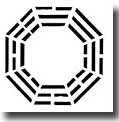
| Home | |||
| About Us | |||
| Overview | |||
| Shaolin | |||
| Hsing Yi | |||
| Tai Chi | |||
| Bagua | |||
| History | |||
| Practice | |||
| References | |||
| Baji | |||
| Health | |||
| Other Styles | |||
|
|
|||
| Links | |||
| Directory | |||
| News | |||
n chinese, "I" means change and "Ching" means book. The I Ching together means 'The Book Of Changes' and is one of the five Classics for Chinese Scholars. Just as Shaolin Kungfu is based on Zen Buddhism, T'ai chi on Taoism, the foundation of Bagua is related to the Kua (Trigrams) of the I Ching. The Bagua (Eight Trigram) consists of eight combinations of three whole and broken lines used in divination. The relationship between the I Ching and the martial arts are explored in the following way:
Fu Hsi (2852-2738 BC), the legendary rule of China, was created with the creation of the Trigram as well as the inventor of fishing, trapping, cooking, the calendar, angular measurement and writing. During the Hsia Dynasty, the trigrams of Fu Hsi were combined into the sixty-four hexagrams, and brief divination texts were added. This became one of the first books, called the Lieu Shan, or Manifestation of Change in the Mountains, and was consulted with the yarrow oracle (Yarrow was considered to be a sacred plant beause it grow only in sacred places). A new form of the divination text renamed the Kuei Tsang, or Flow and Return to Womb and Tomb, was used during the Shang Dynasty. King Wen (1184-1135 B), also known as Ji Chang the marquis of Western Bo and the founder of the Chou Dynasty was another important contributor int he evolution of the I Ching. While in prision, he wrote new divination texts for the hexagrams of the Kuei Tsang, and arranged them in their present order. This work is known as the Pem Ching and consists of the Kua (hexagrams) and Thuan (Judgements). Later, King Wen's son, King Wu and his brother Tan, modified Pem Ching by adding the Hsiao (Lines). This completed the version of the I Ching as it survives to the present day.
The I Ching has became a valuable method for Chinese philosophers to explain their thoughts and theories. Confucius was quoted as saying: 'If many years were added to my life, I would give 50 to the study of the Zhou Yi and might thereby manage to avoid great mistakes." In Chinese society, it is often eblive that those who sought to establish themselves never failed to rely on the guidance of the I Ching. Chinese histories provided the following examples of those that take advantage of the I Ching:
- Li Jing, a famous general who helped establish the Tang Dynasty.
- Zuge Liang, a great strategist of the 3 Kingdoms period.
- Zhang Liang, a famous strategist who played a key role in the founding of the Han Dynasty.
- Ziang Ziya, a strategist who helped establish the Zhou Dynasty.
Description of the Bagua (Eight Trigrams)
- I Ching is predicted by using 6 coins (usually) to get the arrangement of one of the 64 arrangements. In each of these there are 2 types of answer which is positive & negative (‘yin’ & ‘yang’ or the tho opposites). Then it can be divided into 6 more different types of interpretation depending the situation.
- The interaction of the Yin and Yang gives rise to all changes. Yin and yang are not merely opposite states but can be complementary in nature. This is called the unity of opposites.
- Only when one understands the relationship between opposites of the hexagrams will one see the original meanings. Because of this, many people misinterprets the hexagram due to their lack of thorough understanding. If one thinks only of gain and ignores the possibility of failure, he will run into trouble. If one thinks only of living and ignores risks to life, regret will be too late. If one knows only how to move forward and not backward, he will reach a dead end. Sorrow and happiness, poverty and wealth, Yin and Yang will transform from one into the other under certain conditions.
Relationship between Bagua and the Practice of Martial Arts
At the simplist level, Bagua Palms makes use of the geometric frame work of the I Ching as a memory aid for the complex movements, attack and defenses of this style. For example, most styles of Bagua has 64 different techniques (Palms).
Copyright 2002
